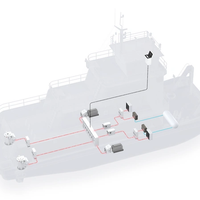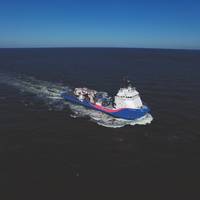World-First: Hydrogen-powered Push Boat

A new vessel being built to operate along the Rhône river in France will be the world's first push boat to run entirely on hydrogen fuel cells.The newbuild for the France-based Sogestran Group subsidiary Compagnie Fluviale de Transport (CFT) is due for delivery in 2021 and will feature a fuel cell based power and propulsion solution from ABB through its role in FLAGSHIPS, the EU-funded initiative to deploy commercially operated zero-emission vessels for inland and short sea operations.
Software Solutions: Monitor & Track

As the maritime industry embraces the digital revolution, companies like GateHouse are poised to prosper. GateHouse in developing software solutions to support optimization, flexibility and mission critical operations for vehicle and vessel tracking, monitoring and satellite communications. We caught up with Michael Bondo Andersen, CEO and founder of GateHouse, for insights on his strategy moving the company forward. Looking at your maritime unit, Big Data is having a transformational impact on global maritime. Please detail your offering.
OSV Technology: Notable Designs & Deliveries

Though the market for Offshore Support Vessels (OSVs) is soft, advances in technology, fit and finish in the sector is unrivaled in any other maritime niche over the past five years. Here’s a look at some of the more notable designs and deliveries. Few vessels have inspired as much attention or coverage as the Harvey Energy, the first OSV of its kind in North America, able to run on both Liquefied Natural Gas (LNG) and diesel. Harvey Energy, chartered to Shell for its deepwater operations in the Gulf of Mexico and owned by Harvey Gulf International marine…
Harvey Energy Begins Work for Shell
Gulf Coast Shipyard Group (GCSG) informed that Harvey Energy, the first LNG vessel operating in the United States—for Shell Upstream America’s deep water operations in the Gulf of Mexico—is fully in service. The first of six LNG OSVs being built for Harvey Gulf International Marine, Harvey Energy is the break-out vessel capable of operating on LNG or diesel and is the result of a forward-thinking operator, complex engineering and sophisticated building. Along with being able to operate on LNG, she also meets the strident criteria of the ABS Enviro+, Green Passport notation. When operating on only LNG, this vessel meets the new Tier IV sulphur and nitrogen oxide emissions regulations—part of the North American Emission Control Area (ECA).
First Grain Shipload Leaves ADM Brazil Port
The first loaded vessel has departed Archer Daniels Midland Company’s (ADM) new export terminal in Barcarena, in the northern Brazilian state of Pará. ADM explains that the terminal is a significant addition to ADM’s expanding logistical network in Brazil, and offers an efficient pathway for the export of grain from the increasingly productive western and northern regions of the country. ADM received approval to begin operations at the terminal at the end of July 2014. “We are pleased to see operations underway at our new terminal in Barcarena,” said Valmor Schaffer, president, ADM South America. ADM acquired the terminal in 2012. It currently has the capacity to handle approximately 1.5 million metric tons of grain on an annual basis…
SEEMP: Potential Win-win for Commercial Vessels
SEEMP can make a fleet more competitive in a difficult business environment while reducing its impact on the environment. In January 2013, the International Maritime Organization (IMO) put into force new regulations intended to improve the energy efficiency of ships over 400 gross tonnes (gt) on international voyages, including a requirement to keep on board a ship-specific Ship Energy Efficiency Management Plan (SEEMP). This initiative is intended to reduce ship greenhouse gas (GHG) emissions by encouraging ship operators to reduce energy consumption. Since that time, there has been much discussion within the shipping industry about the potential domestic enforcement of the SEEMP. Recently, the U.S.
Miller Boat Line “Green” Ferry
Miller Boat Line has begun using a 10-20 percent biofuel mix in one of its passenger vessels, the William Market, and has plans to eventually use it in all four of its vessels. The biofuel, G2 Diesel, provides 15 percent better fuel economy than traditional diesel and leaves a cleaner wake, protecting Lake Erie and generating fewer harmful emissions. Miller Boat Line has long been the most value-friendly way to travel to Put-in-Bay and the only way to bring vehicles to the island. G2 Diesel, is manufactured by a local company named 11 Good Energy, headquartered in Canton, Ohio. G2 Diesel is made primarily from soybean oil and ethanol and has a distinctly different aroma than traditional diesel when burned: some say it smells like French fries or butterscotch.







